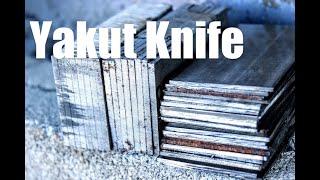
Forging The Blade Of The Sakha / Yakut People In Siberia
Комментарии:

Nice to hear someone use the CORRECT term of “pattern welded”…..Damascus it isn’t……..
Ответить
Beautiful knife !
Ответить
Try it in your other hand.
Ответить
Beautiful Yakut!
Ответить
Very nice! One of the nicest Yakut knives I've ever seen. I won't be doing pattern welded, but I can't wait to make some of these. I love the design.
Ответить
Excellent purpose built tool/weapon
Ответить
good job,but its not true saha knife,its must be with flat grind and one side sharpened as you did.and fuller is novadays stylish thing,bunch of dugged up blades from past years are just one side flat grinded without fuller
Ответить
First of all, WHAT A GORGEOUS BLADE! Well done. From my understanding of the design, these knives are primarily used to process meat. The design is intended to flat spiral out larger pieces of meat (like a roast) getting it thin enough for drying/preserving. They make left and right-hand versions of the knife depending on what side the fuller is on. I have a few of them and they really are effective tools for the task it was designed for.
Ответить
I have some memory of a Yakut man making one of these, As I understood it the blades were honed on the convex side, not the hollow, could that be right ?
Ответить
Якутов никто не истреблял в отличие от индейцев в Америке!
Ответить
I literally catch myself commenting on how awesome it is to hear the technical side of the metallurgy and the technique used in your videos. Love it, thank you for sharing
Ответить
Saka were Indo-Iranian people( aka Scythian) Buddha was saka. The closest existing people today are Ossetians. Yakuts are not Indo-Iranian and not related to saka. You are right, however, Yakuts are related to native Americans
Ответить
Beautiful knife!
Ответить
My first attempt at a forged blade was an attempt at a Yakut. It was fun. I also ended up loosing most of the hammered fuller when I finished the blade up.
Ответить
I bet having to cut frozen meat would require a more robust knife. Yakut is such a fascinating place and culture. I’m indigenous American and I love your curiosity about indigenous culture.
Ответить
Fire Creek Forge,greetings!
Neat,competent job on the knife,much respect.
A couple pointers,just in case: Sakha are a very ancient people,and their iron and steel metallurgy goes back a Very long way.
(In one of their "olonho"-an ancient epic poems cycle-theres a poetic but very technical and precise description of how to differentiate between the low-/med.-/and high-carbon product(from their bloomery process,basically a "tatara").
So i'd not recommend experimenting with a rough-forged fuller,as these are predominantly a fantasy perpetrated by the Russian makers,and are historically incorrect,and in a way a slight aimed to denigrate,to denote as "savage"(right along with a term Yakut,also originally an insulting term).
A very wide fuller is not very old,relatively speaking,going back to maybe mid-19th c. or so,the older originals having either single or multiple narrow fullers,or none at all.
If you have some time,try checking out a UTube channel called Dobun Knives. Its by a young Sakha maker,Aleksey,who studies the traditional,older work,and although none of his videos are in English,theres a few specifically on older knives,and there's much visual material that would speak to you as to a fellow metalworker,no verbiage necessary.
They're always some Very solid,practical reasons for why the older knives were shaped a certain way(like the handle tapering toward the blade is for holding firmly in the sheath),also the sizes and proportions of each blade was(is)fairly strictly according to a certain type,each meant for use for a particular task and/or material.
You've done a corker job of this one,but judging by your obvious interest in authenticity i thought I'd mention some of these things,not as criticism but a way to learn more.
Some of the oldest knives of this culture,btw,are in the Smithsonian collection,and some have been published fairly recently,but in an edition so costly I'll not even name it here!:)
Watching some of Alekseys stuff will be even more informative though.
Very best of luck,and keep up that lovely work.

👎🏿👎🏿👎🏿👎🏿👎🏿👎🏿👎🏿👎🏿👎🏿👎🏿👎🏿
Ответить
ADS 💩💩💩💩💩💩💩💩💩😠😠😠😠😠😠
Ответить
ADS...😠😠😠😠😠😠😠😠😠😠😠😠💩
Ответить
ADS 💩💩💩💩💩💩💩💩💩💩💩💩
Ответить
You can enhance the pattern by etching the steel in concentrated hot instant coffee (NO DECAF!) after the Ferric Chloride etch.
Ответить
What a unique blade geometry, have never seen anything like it. I would have to make a left and right handed version if it were me.
Ответить
+1 for calling it patterned welded steel, and not Damascus. Damascus was Wootz crucible steel and the composition is not really known. From wikipedia.
Damascus steel is the forged steel of the blades of swords smithed in the Near East from ingots of Wootz steel either imported from Southern India or made in production centres in Sri Lanka, or Khorasan, Iran. These swords are characterized by distinctive patterns of banding and mottling reminiscent of flowing water, sometimes in a "ladder" or "rose" pattern. Such blades were reputed to be tough, resistant to shattering, and capable of being honed to a sharp, resilient edge.

Does it matter which side of the blade is concave/fullered ? Left handed vs. right handed ?
Ответить
Это не якут ! Даже не близко ! Приезжайте в Якутию и посмотрите какие ножи желают там ! Но тоже красиво !
Ответить
Хорошая работа, очень замечательно что затронули тему этнических ножей , жду следующих серий. Википедия не всегда доставерно отражает историю. 😊
Ответить
What happened to leaving Texas and moving back?
Ответить
According to SurvivalRussia the reason for the shape of the Yakut knife is conservation of steel. Less was required to produce it. He has a channel, bushcraft/winter survival etc.
Ответить
Damascus was used because they have very bad steel with modern steel there is no reason to every make a Damascus knife
Ответить
I am wondering if this knife shape is right-hand/left-hand specific. The way you were using it on the piece of wood, it seems it would not work well for a left handed person.
Ответить
Thank you for using the correct term of "pattern-welded"
Ответить
Part knife part gardening tool/root digger/clamshell scoop. Lol, I don't know, just musing.
Ответить
Nice blade a concept
Ответить
I read the title as building a Yakult knife at first
Ответить
where is the Damascus steel at ?
Ответить
I love Yakut Turks knife. That really just made for being useful.
Fact about knife, on the end of handle you should make same "egg design". That's mean handle's end should more round. And second, that knife should not dip in the water bcs all that shape.
Love your works and explaining videos. Good knife, like every time.

Awesome blade.
Ответить
SAKHA knife
Ответить
How many tonnes is your Press? And what burners are you using? I can't get my forge up to forge welding temps currently
Ответить
There should deff be a right and left handed model
Ответить
from what i understand the yakut blades were originally bone and when metal became available they simply copied the bone version. i also see versions with a chisel grind which is good for scraping.
Ответить
Nice!
Ответить
Was there a history of them being ambidextrous? Cause to me it looks like knife that would require really good hand eye coordination from both sides?
Ответить
very informative video!
Ответить
Austin? As in Austin Hensley from Hensley Handmade Knives?? Also a good buddy of mine! (if that's the case haha)
Ответить
Looks cool! Can’t wait to see how it develops!
Ответить
I really love when you do things like this. Keep working with the design and add it to the regular rotation.
Ответить

























